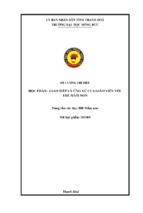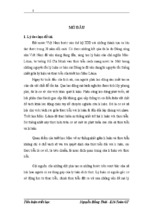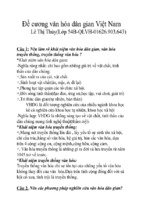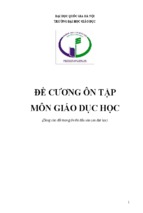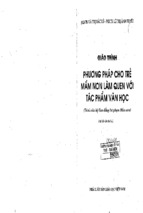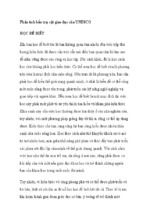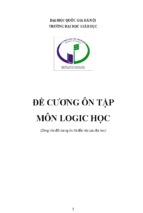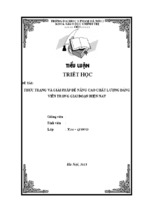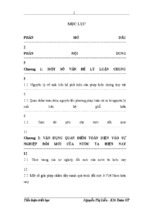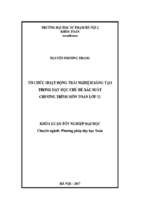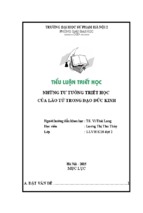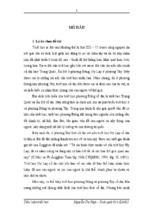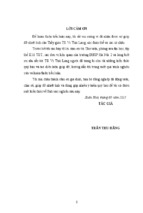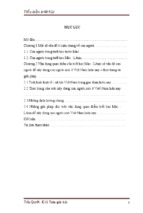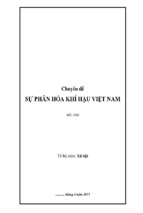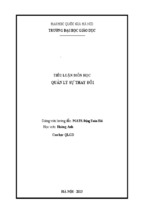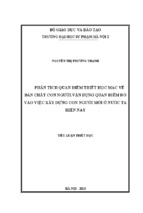THAI NGUYEN UNIVERSITY
SCHOOL OF FOREIGN LANGUAGES
DO THI NU
AN INVESTIGATION INTO LEARNING AUTONOMY
IN ENGLISH VOCABULARY LEARNING
AMONG GRADE 12 STUDENTS
M.A. THESIS
Field: English Linguistics
Code: 8220201
THAI NGUYEN – 2020
ĐẠI HỌC THÁI NGUYÊN
TRƯỜNG NGOẠI NGỮ
ĐỖ THỊ NỤ
NGHIÊN CỨU NĂNG LỰC TỰ HỌC TỪ VỰNG
TIẾNG ANH CỦA HỌC SINH LỚP 12
LUẬN VĂN THẠC SĨ
Ngành: Ngôn ngữ Anh
Mã số: 8220201
THÁI NGUYÊN - 2020
DECLARATION
I declare that this research report entitled ―An investigation into learning
autonomy in English vocabulary learning among grade 12 students‖ has been
composed by myself, and described my own work, unless otherwise acknowledged
in the text. I confirm that this work is submitted in partial fulfillment of the
requirements for the degree of master at School of Foreign Languages, Thai Nguyen
University. This work has not been and will not submitted for any other degree at
any other institution of higher education.
Author’s signature
Approved by
SUPERVISOR
Nguyen Thi Que, PhD
Do Thi Nu
Date: November, 2020
i
ACKNOWLEDGEMENTS
I am deeply indebted to a number of people for helping me to make this M.A
thesis possible.
First and foremost, my deepest gratitude goes to Dr. Nguyen Thi Que my
supervisor, who supported and encouraged me generously throughout this study.
Without her excellent academic guidance and support, my thesis would not have
been completed.
I would like to sincerely thank the anonymous participants who contributed
data to this study. Without their outstanding cooperation, this thesis would not have
been completed.
My appreciation is also extended to a number of staff members of Ly Nam
De high school for their assistance is statistical issues and for their assistance in
editing work.
I would like to thank my family, especially my parents and my husband for
their constant source of love, support and encouragement in times of difficulty and
frustration.
Finally, I would like to thank my readers for their interests and comments on
this thesis.
While I am deeply indebted to all these people for their help to the
completion of this thesis, I myself remain responsible for any inadequacies that are
found in this work.
ii
TABLE OF CONTENTS
DECLARATION ......................................................................................................... i
ACKNOWLEDGEMENTS ........................................................................................ii
TABLE OF CONTENTS .......................................................................................... iii
LIST OF TABLES ...................................................................................................... v
LIST OF FIGURES.................................................................................................... vi
LIST OF ABBREVIATIONS ...................................................................................vii
ABSTRACT ............................................................................................................ viii
CHAPTER 1: INTRODUCTION ............................................................................ 1
1.1. Rationale .............................................................................................................. 1
1.2. Statements of the problems and aims of the study ............................................... 3
1.3. Scope of the study ................................................................................................ 4
1.4 Significance of study ............................................................................................. 4
CHAPTER 2: LITERATURE REVIEW ................................................................ 5
2.1. Learning autonomy .............................................................................................. 5
2.1.1 Learner autonomy in language learning ...................................................... 7
2.1.2 Learner autonomy ........................................................................................ 8
2.1.3 Level of learning autonomy......................................................................... 9
2.1.4 Characteristics of autonomous language learners ..................................... 13
2.2 Factors affecting learner autonomy..................................................................... 13
2.2.1 The Role of Learner Themselves .............................................................. 13
2.2.2 The Role of Teachers ................................................................................. 14
2.2.3 Learner motivation and attitude................................................................. 15
2.2.4 Self-regulation ........................................................................................... 15
2.2.5 Self-efficacy............................................................................................... 15
2.2.6 Self-determination ..................................................................................... 16
2.3 Vocabulary learning strategies ............................................................................ 16
2.3.1 Language learning strategies ..................................................................... 17
2.3.2 Classification of vocabulary learning strategies ........................................ 18
2.4 Previous Studies .................................................................................................. 25
iii
CHAPTER 3: RESEARCH METHODOLOGY ................................................. 29
3.1. Research Design ................................................................................................. 29
3.2. Subjects and locale of the study ......................................................................... 29
3.3. Research Instruments ......................................................................................... 29
3.3.1. Checklist: Learner‘s Autonomy Questionnaire (LAQ) ............................ 30
3.3.2. Questionnaire: Vocabulary Learning Strategies Questionnaire (VLSQ) ..... 30
3.4. Data Gathering Procedure .................................................................................. 31
3.5. Data analytical method ....................................................................................... 31
CHAPTER 4: PRESENTATION, INTERPRETATION, AND ANALYSIS
OF DATA ................................................................................................................. 33
4.1. Demographic information of the participants .................................................... 33
4.2. The use of students‘ vocabulary learning strategies .......................................... 34
4.2.1 General Vocabulary learning strategies by participants ............................ 34
4.2.2 Specific Vocabulary learning strategies by participants ........................... 35
4.3. Levels of learner autonomy................................................................................ 42
4.4. Relationship between learner autonomy and students‘ uses of vocabulary
learning strategies ...................................................................................................... 47
4.4.1. The results of determining the form, direction and degree of
correlation on a graph and by regression analysis .............................................. 47
4.4.2. The results of determining the relationship between the students‘ uses
of VLS and their levels of learning autonomy with Paired Samples T-test ....... 51
4.4.3. Summary ................................................................................................... 52
CHAPTER 5: SUMMARY OF FINDINGS, CONCLUSIONS AND
RECOMMENDATIONS ........................................................................................ 54
5.1 Summary of findings ........................................................................................... 54
5.2. Conclusion .......................................................................................................... 55
5.3. Recommendations .............................................................................................. 56
5.4. Limitations of the study and suggestions for further research: .......................... 57
REFERENCES ........................................................................................................ 58
APPENDIX 1 ........................................................................................................... 62
iv
LIST OF TABLES
Table 4.1. Students' background information ......................................................... 33
Table 4.2: General Vocabulary learning strategies by participants ........................ 34
Table 4.3: Memory strategies employed by participants ........................................ 35
Table 4.4. Determination strategies employed by participants: ............................. 37
Table 4.5: Social strategies employed by participants ........................................... 38
Table 4.6: Cognitive strategies employed by participants ...................................... 39
Table 4.7: Metacognitive Strategies employed by participants .............................. 40
Table 4.8: Learner autonomy checklist .................................................................. 43
Table 4.9: The results of regression of analyses between the students‘
learning autonomy and their uses of vocabulary learning strategies .... 49
Table 4.10: Model Summary .................................................................................... 49
Table 4.11: Coefficient size in the pattern ................................................................ 50
Table 4.12. Mean and SD of the scores of the two variables Paired Samples
Statistics ................................................................................................. 51
Table 4.13: The correlation between students' uses of Vocab learning
strategies and Levels of learners' autonomy .......................................... 51
Table 4.14: The Paired Samples Test Analysis of the scores between 2
variables ................................................................................................. 52
v
LIST OF FIGURES
Figure 4.1.
Distribution of the use of vocabulary learning strategies.................... 42
Figure 4.2.
Distribution of students‘ levels of learning autonomy ........................ 46
Figure 4.3.
The linear relationship between learner autonomy and students‘
use of vocabulary learning strategies .................................................. 48
vi
LIST OF ABBREVIATIONS
Abbreviate
Meaning
CLT
Communicative Language Teaching
EFL
English as a Foreign Language
LND
Ly Nam De high school
LA
Learning Autonomy
LLS
Language Learning Strategies
VLS
Vocabulary Learning Strategies
vii
ABSTRACT
The aim of this study was to improve students‘ uses of vocabulary learning
strategies and levels of learner autonomy by determining the relationship between
them. To be more specific, the researcher firstly aimed at exploring students‘ levels
of learning autonomy, finding out students‘ vocabulary learning strategies and
finally figuring out the relationship between learning autonomy and students‘ use of
vocabulary learning strategies.
The study employed the correlational research design. A total of 145 students
of grade 12 at Ly Nam De High School of Thai Nguyen province participated in the
study by giving their evaluation of their learning autonomy and VLS through two
different instruments of a questionnaire and a checklist.
Results of the study revealed that vocabulary learning strategies were used at
medium level of frequency by grade 12 students. In addition, the levels of learning
autonomy by these participants was also measured at medium level. Significantly,
there was a linear, positive and rather strong correlation between students‘ uses of
vocabulary learning strategies and their levels of learning autonomy.
The findings of the study have proposed some implications for
administrators, other researchers, English educators and students on the need to
enhance students‘ learning autonomy in order to improve English vocabulary in
particular and English language teaching and learning in general in Vietnam.
viii
CHAPTER 1:
INTRODUCTION
1.1. Rationale
English has gained its predominant role in the foreign language teaching
program at tertiary level in Vietnam for the last few decades (Hoang Van Van,
2008). After Vietnam opened its door to reintegrate to the world in 1986, under the
impact of globalisation and internationalisation in higher education, the need to
enhance English language teaching and learning has become one of the most
important aims of the higher education reform process in Vietnam. With the Higher
Education Reform Agenda (HERA)1 , Vietnamese government aims to ‗formulate a
strategy on international integration, raise the cooperation capacity and
competitiveness of Vietnamese tertiary education‘ (p. 7).
Vocabulary is an important sub-field of language learning, with which
learners are able to use four language skills: listening, speaking, reading, and
writing (Nation, 2001; Richards & Renandya, 2002; Schmitt, 2010). This
importance is recognized regardless of L1, L2, or EFL learning (Decarrico, 2001).
However, learning words is an incremental process involving a variety of subprocesses. One process is primarily concerned with lexical entry, i.e., the
enrichment, refinement of lexical information, which many EFL tertiary-level
learners lack (Nan, 2004). In other words, with a limited vocabulary size, it is very
difficult for learners to effectively engage in an intensive or extensive reading
course. Accordingly, they need an effective way to improve their vocabulary size.
Concerning vocabulary acquisition, there are mainly two approaches: incidental
learning and intentional learning (Schmitt, 2000, 2008; Teng, 2014a). In some
studies, for example, Paribakht & Wesche (1993, 1997) fully supported the idea that
intentional vocabulary learning yielded a better result than incidental vocabulary
learning. However, when considering the limited classroom time for intentional and
explicit teaching of every word, many researchers have resorted to incidental
vocabulary learning. Incidental learning, which is learned in an implicit way, is a
―by-product‖ of any teaching activity (Hulstijn, 2001, p.266). When learners try to
1
understand the embedded meaning of the context, then the acquisition of words
occurs subconsciously (Paribakht & Wesche, 1999). Many studies have been
conducted on the effects of extensive reading on incidental vocabulary learning
(Day, Omura, & Hiramatsu, 1992; Horst, 2005; Teng, 2015; Webb, 2008).
However, incidental vocabulary gain is very limited. Therefore, other factors that
affect vocabulary learning have been suggested; for example, topic familiarity, time
spent on learning, level of intake, and strategies (Nation, 2008; Pulido, 2004). The
present study investigated how EFL learners perceive out-of-class autonomous
vocabulary learning strategies, and reported some suggestions on how to encourage
learner autonomy with the support of teachers.
Language learning and teaching methods have seen many innovations from
grammar-translation which focuses on form to communicative language teaching
(CLT) which focuses on meaning. The basic principles of CLT emphasize the roles
of learners which have been shifted from passively received information from
teachers to actively find the information from peers, other sources for their deep
understanding. In order to be benefited from resources available, learners should
become 'self-instruction', 'self-access', 'self-study', 'self-education' learners. In other
words, 'the autonomous learner' is what a student should become (Richards, 2006)
since learner autonomy is believed to produce positive outcomes to develop lifelong learners.
One of the aspects of language learning that has the greatest potential for
adopting learner autonomy is vocabulary (McCathy, 1990). However, Wenden
(1991) stress that being aware of different learning strategies also help language
learners become more efficient autonomous learners and users. Therefore, it is
essential to determine whether there is a relationship between learning strategies
and learner autonomy to better students‘ learning outcomes in vocabulary or not.
Vocabulary learning is incredibly noteworthy to English language
acquisition. It is unfeasible for a learner to communicate without the required
vocabulary. In high education levels, learners are habitually forced to become
autonomous and make conscious effort to learn vocabulary outside of the
2
classroom. Consequently, the autonomy of the learners plays an important role in
developing and enhancing their vocabulary. Learner autonomy is a huge assistance
for learners in vocabulary learning since it provides the learners with numerous
diverse privileges such as independency from teacher. The researcher investigated
whether there is any statistically significant relationship between learner autonomy
and vocabulary learning strategies use in Ly Nam De‘students with different
language proficiency levels. To meet the above purpose, a total number of 145 male
and female grade 12th participated in this study. The methodology underlying this
study was quantitative (through the administration of questionnaires and a
checklist). The quantitative data were analyzed using a set of correlational analysis
revealing a significant positive correlation between learner autonomy and
vocabulary learning strategies.
This study attempted to examine the relationship between students‘ levels of
learning autonomy and their uses of vocabulary learning strategies by grade 12
students at Ly Nam De High School, Thai Nguyen province.
1.2. Statements of the problems and aims of the study
The aim of this study was to improve the use of vocabulary learning
strategies and learner autonomy by determining the relationship between them.
To be more specific, the researcher firstly aimed at exploring students‘ levels
of learning autonomy, finding out students‘ vocabulary learning strategies and
finally figuring out the relationship between learning autonomy and students‘ uses
of vocabulary learning strategies
With the above-mentioned aims, the study tries to answer the following
research questions:
1. What are the students' uses of vocabulary learning strategies?
2. What are the students' levels of learning autonomy?
3. What is the relationship between the students' levels of learning
autonomy and students’ uses of vocabulary learning strategies?
3
Hypotheses
The following hypotheses were tested for correlations:
* Null hypothesis: There is no relationship between the students‘ uses of
VLSs and the learner autonomy.
* Alternative hypothesis: There is a relationship between the students‘ uses
of VLSs and the learner autonomy.
1.3. Scope of the study
The study was carried out at Ly Nam De High School where the researcher
has been working for years as a teacher of English. It is a newly established high
school located in Pho Yen town, Thai Nguyen province with 24 classes and 947
students from grades 10 to 12.
This study involved 145 students in grade 12 who joined to answer a
checklist on learning autonomy and vocabulary strategies questionnaire.
1.4 Significance of study
The findings of the current study suggest some implications both for English
foreign language teaching and learning, especially in Vietnam.
a) to the researcher, the research can give a practice in developing her
knowledge and skill in problem-solving processes.
b) to the teachers of English in Ly Nam De high school, the research can be
used as a source of information about ways to improve the vocabulary teaching and
help the teachers find more appropriate and effective ways to make their students
become autonomous and independent leaners of English.
c) to 12th grade students at Ly Nam De high school, the research is hoped to
make them more interested and motivated to learn vocabulary as well as learn
English well.
d) to other researchers, the research can give general knowledge of how to
extend students‘ English vocabulary and as the foundation for the next research.
4
CHAPTER 2:
LITERATURE REVIEW
This part presents the theories of learning autonomy and learner autonomy,
factors affecting learner autonomy language learning strategies in general and
vocabulary learning strategies in particular and some related studies on relationship
between vocabulary learning strategies and learning autonomy. The key ideas to be
discussed are about the effect of LLSs and learner autonomy on successful language
learning which have been managed so far.
2.1 . Learning autonomy
The term autonomy has been increasingly used in the educational field since
last century and has become an important element in education. It is seen today as
an effective alternative to traditional education that has greatly enriched educational
practice. It would be an impossible task to write an exhaustive list of the social
contingencies and currents of thought which contributed to the inception and the
increased attention of autonomy in education.
In formal educational contexts, the basis of learner autonomy is acceptance
of responsibility for one's own learning; the development of learners autonomy
depends on the exercise of that responsibility in a never-ending effort to understand
what one is learning, why one is learning, how one is learning, and with what
degree of success; and the effect of learner autonomy is to remove the barriers that
so easily erect themselves between formal learning and the wider environment in
which the learner lives.
Autonomous learning is more effective than non-autonomous learning. In
other words, the development of autonomy implies better language learning. This is
one of the three hypotheses which almost all research in the field of autonomy is
based on, and has implications for (Benson, 2001, p. 183). As Benson (2001, p.
189) stated, many advocates for autonomy are concerned primarily with the ability
to learn effectively in terms of personal goals. Although autonomy may ultimately
lead to greater proficiency in language use, whether autonomous learners learn
more than non-autonomous learner is a secondary issue. In recent years, however,
5
the contribution of practices associated with autonomy to language proficiency has
become a critical issue for two reasons. One reason is that researchers are
increasingly beginning to understand that there is an intimate relationship between
autonomy and effective learning. However, to date this relationship has largely been
explored at the level of theory, and lacks substantial empirical support. Another
reason is that world-wide concern with accountability in education is increasingly
obliging teachers to demonstrate the effectiveness of their practices in terms of
proficiency gains. If researchers can show that practices aiming at greater autonomy
also lead to greater proficiency, in whatever terms this is measured, their arguments
will be strengthened. For both practical and theoretical reasons, therefore, there is a
pressing need for empirical research on the relationship between the development of
autonomy and the acquisition of language proficiency. The hypothesis that practices
intended to foster autonomy lead to better language learning can be demonstrated
empirically at two levels. One level is that research can attempt to show that a
particular form of practice associated with autonomy produces gains in proficiency
that are equal to or greater than other forms of practice. Another level is that
research can attempt to describe the ways in which proficiency develops as a result
of the distinctive qualities of practices designed to promote autonomy. Comments
made on the design of action research projects focusing on gains in autonomy apply
equally to research on proficiency gains. However, research on proficiency gains
faces two additional problems. The first concerns the selection of relevant measures
of proficiency. The second problems concerns the life cycle of programmes aiming
to foster autonomy (Benson, 2001, p. 191). Research that is able to document
changes in the quality of learning in such programmes will contribute a great deal to
our understanding of the relationship between the development of autonomy and the
development of proficiency. To date, however, only a few researchers explored the
relationship between learner autonomy and language proficiency (Ablard and
Lipschultz, 1998; Corno and Mandinach, 1983; Risenberg and Zimmerman, 1992;
Zhang and Li, 2004). Corno and Mandinach (1983, p. 89) initially proposed that
learner autonomy could help to improve the language proficiency of learners and
6
concluded that autonomous learners were the learners of high language proficiency.
Ablard and Lipschultz (1998, p. 97) also found out that different high-achievement
students applied different autonomous strategies. Risenberg and Zimmerman (1992,
p. 120) further pointed out that a high degree of learner autonomy among the highachieving students would achieve high scores and the learner with low degrees of
learner autonomy was likely to risk achieving the low scores if learner autonomy
could augment the academic scores. Zhang and Li (2004, p.21) concluded that
learner autonomy was closely related with the language levels and its Pearson
Coefficient amounted to 0.6088 based on the comparison between the subjects in
China and Europe.
2.1.1 Learner autonomy in language learning
Benson (2008) highlights the importance of learning about the perspectives
held by teachers and learners on learner autonomy. Moreover, he emphasizes that
learners and teachers do not necessarily share the same perspectives. Teachers,
Benson argues, focus more on the institutional aspect of learner autonomy with
classroom arrangements in place and the students taking charge of the
responsibilities determined and established therein. The learners, on the other hand,
hold a broader view of learner autonomy. To learners, autonomy is concerned with
their lives beyond their classrooms.
The three basic pedagogical principles which underlines autonomy in
language learning is learner involvement (engaging learners to share responsibility
for the learning process), learner reflection (helping learners to think critically
when they plan, monitor and evaluate their learning) and appropriate use of target
language (using target of language as the principal medium of language learning).
Holec (1981), Allwright (1990) and Little (1991) theorize that autonomous
learners can be seen as those who are able to reflect on their own learning through
knowledge about learning and who are willing to learn in collaboration with
others. These learners understand the purpose of their learning program, explicitly
accept responsibility for their learning, share in the setting of learning goals, take
initiatives in planning and executing learning activities, and regularly review their
7
learning and evaluate its effectiveness. In other words, there is a consensus that
the practice of learner autonomy requires insight, a positive attitude, a capacity for
reflection, and a readiness to be proactive in self-management and in interaction
with others.
2.1.2 Learner autonomy
Learner autonomy has been identified as a complicated capacity that
potentially has a great impact on personal growth and achievement. Different
mediated attributes associated with situational, psychological, cultural and
political aspects of this construct have been developed and examined to facilitate
the promotion of this educational goal. Taking this into account, this paper adopts
socio-cultural perspective to localize the situation of EFL learning in higher
education in Vietnam. Personal reflections and part of the data generated from a
large-scale project are extracted to illustrate a dilemma of the context where
learner autonomy can be either fostered or hindered deliberately within various
community constraints.
In about twenty years after the Second World War, autonomy, self-direction,
and self-access that all refer to the sameconcept entered into the field of education
and went under analyses and researches, and as the time passed, it becamemore and
more familiar in the field of education (Gremmo & Riley, 1995). Since 1980s,
autonomy in language learninghas been a subject of prevalent debate.According to
Littlewood (1999), definitions of autonomy have varied, but they have typically
included these vital features.
- Students should take responsibility for their own learning.
- Taking responsibility‘ involves learners in taking ownership (partial or
total) of many processes which have traditionally belonged to the teacher, such as
deciding on learning objectives, selecting learning methods and evaluating progress.
Little (2007, p.26) defines learner autonomy as "Learner autonomy is the
product of an interactive process in which theteacher gradually enlarges the scope
of her learners‘ autonomy by gradually allowing them to take more control of the
process and content of their learning‖. Littlewood (1996) believed that the
8
influencing goal of teaching is to produce learners that can act and think more
independently, i.e. more autonomously, and a strategy for developing autonomy is
the main target of language teaching. As Scharle and Szabo (2000) pointed out, we
do not consider of conscientious learners as role models (or teacher‘spets), but as
learners who admit the idea that their own endeavor are significant to develop in
learning, and behave accordingly. Consequently, when doing their homework or
answering a question in class, they are not trying to satisfy the tutor, or to get a
good mark. They are basically making an attempt in order to learn something.
While it is not known when the term ‗learner autonomy‘ was first used as
pedagogy, it appeared officially for the first time in second language education in
the Council of Europe Modern Languages Project in 1979 by Holec. This led to the
publication of Holec‘s (1981: 3) seminal report, in which he defined learner
autonomy as ―the ability to take charge of one‘s own learning‖. In this definition,
Holec treated learner autonomy as an attribute of the learner. Following this,
various other definitions of learner autonomy have been used. For example,
Wenden (1999) indicated the importance of metacognitive awareness when she
claimed that true learner autonomy refers to how students reflect on their learning
and how they are able to realize when they have effective learning opportunities. In
another example, Littlewoods (1996: 427) took the notion of autonomy as
―learners‖ ability and willingness to make choices independently‖. He argued that
―this capacity depends on two main components: ability and willingness‖ (p. 428).
These two abilities are interdependent and are divided into subcomponents of
knowledge about the alternative choices and skills available for carrying out
appropriate choices. Willingness depends on the motivation and confidence a
person has in order to take responsibility for necessary choices. In order to become
autonomous successfully, a person needs to have the four subcomponents of
knowledge, skills, motivation, and confidence. Littlewoods (1996) also suggested
that these components be focused in the development of learner autonomy.
2.1.3 Level of learning autonomy
Littlewood (1999) highlights the interpersonal environment which
facilitates LA through the provision of help and resources, personal concern,
9
involvement of others, opportunities for making choice, and freedom from being
controlled by external agents. He distinguishes two levels of autonomy: proactive
and reactive autonomy. The former refers to situations where learners are able to
take charge of their own learning by setting up their personal agendas and
directions, and evaluating progress in the learning process. The latter is considered
a preliminary step towards the former. Reactive autonomy encourages learners to
learn without being forced. Although learners do not create their own directions,
when a direction has been set up by teachers or the curriculum, reactive autonomy
enables them to autonomously organise their resources to achieve their objectives
and goals. Collaborative and cooperative learning strategies by Flannery (1994)
are used by Littlewood (1999) to manifest distinctions between proactive and
reactive levels of LA. Central to collaborative learning strategies is learners
having a greater degree of choice and judgment about what and how they should
learn, and they themselves set the agenda for their learning. Employing
cooperative learning strategies, learners work independently on tasks but rely on
the teacher for setting up the agenda for learning. Littlewood (2002) believes that
in order to move from reactive autonomy to proactive autonomy, there should be a
shift from cooperative learning which is controlled by teachers or the syllabus to
collaborative learning which is based on learner-directed activities where they
select the content and methods of their learning. He followed Ribe and Vidal
(cited in Littlewood, 2002, p. 35) to construct his framework for LA
developmental process. At the starting point, collaborative tasks are intended to
build up learners ‟ communicative ability through the application of CLT. The
next step is to increase 35 both communication skills and cognitive strategies to
process information. These cognitive strategies include activities aimed to enhance
learners ‟ problem solving and analysing skills necessary for the task completion.
The purpose of the third stage is to develop students ‟ personal and interpersonal
skills by learning and using the target language. Collaborative learning, therefore,
is at the heart of proactive autonomy.
Engaging learners in communication-oriented activities is only the first step
in the LA development process. It is where the principles of CLT and LA overlap.
10
- Xem thêm -


